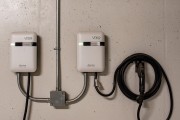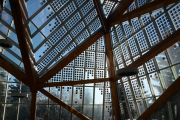The Government of Alberta has promised to make energy efficiency a priority. One of the key areas where improvements can be made is the energy efficiency in Alberta’s buildings, as we outline in a new report.
Housing
Alberta’s housing stock has a lot of room to improve. Figure 1 shows how heating requirements in residential buildings in Alberta have steadily declined over time — but this also illustrates how substantial efficiency gains can be made in existing buildings (especially older buildings). There is still much room for improvement for our houses, since even our newer buildings still use much more energy than high efficiency “passive houses”.

Alberta has been a laggard in adopting more stringent requirements in its building code for new houses, with neighbouring provinces requiring higher standards. For example, a new home built in Fort McMurray in 2014 is required to have wall insulation values that are 50 per cent less than those in The Pas, Manitoba (a city with a comparable annual heating demand). The Government of Alberta is currently in the process of addressing this by adopting the national energy efficiency standards for new construction.
In existing buildings, a number of proven energy efficiency measures (high efficiency lighting, programmable thermostats, low-flow showerheads) have not been well adopted in Alberta. For example, only 40 per cent of households have programmable thermostats that ensure the nighttime winter temperature is lowered automatically.
As well, only 7 per cent of Albertans have conducted an energy audit in the past 10 years, suggesting that many economic energy efficiency measures remain undiscovered by homeowners. This limited interest in audits was observed during the Federal EcoENERGY retrofit program, where lower rates of participation were found in Edmonton and Calgary when compared with many other Canadian cities (Figure 2). However, significant energy efficiency improvements were achieved through the retrofits that did occur; in Calgary and Edmonton, EnerGuide for Homes scores improved by roughly 10 points on average, to 69 and 70, respectively (the range for an existing home to be considered energy efficient is roughly 66 – 74).

Commercial buildings
When we look at commercial buildings, some progress has been observed through the adoption of green building certification and through energy demand reduction goals set by progressive property managers. However, more opportunities for efficiency gains still exist. In a sample of Calgary office buildings, the average energy intensity recorded was 380 ekWh/m2; contrast this with what is possible with more efficient new construction, such as the new Child Development Centre at the University of Calgary campus, which has an energy intensity that is a third of this average.

Best practices
Our report describes many of the best practices observed in jurisdictions across Canada and around the world, though most of these have achieved limited adoption in Alberta. Of the best practices identified, four were highlighted by stakeholders as being particularly relevant and useful in the Alberta context:
- Mandatory building energy labeling
- Informative billing / home energy reports
- Building code improvements
- Mandatory energy audits / reporting / energy managers
Players and Leaders
 We also assessed the contribution of stakeholders (industry, government, owner/operators, advocacy/education, and financial services) in realising Alberta’s energy efficiency goals. The interplay of these actors ultimately determines how efficient Alberta’s buildings are; a power map laying out the interaction of these actors towards making buildings more energy efficient is presented in our report. One important role that we identified was that of Sustainable Energy Organizations. Since these are the only stakeholders who include promoting efficiency as one of their primary objectives, they have the potential to play a key role in driving Alberta’s buildings towards greater energy efficiency.
We also assessed the contribution of stakeholders (industry, government, owner/operators, advocacy/education, and financial services) in realising Alberta’s energy efficiency goals. The interplay of these actors ultimately determines how efficient Alberta’s buildings are; a power map laying out the interaction of these actors towards making buildings more energy efficient is presented in our report. One important role that we identified was that of Sustainable Energy Organizations. Since these are the only stakeholders who include promoting efficiency as one of their primary objectives, they have the potential to play a key role in driving Alberta’s buildings towards greater energy efficiency.
In 2010, buildings were responsible for nearly one-third of all energy consumption in Canada.
If successful, an initiative to increase the energy efficiency of buildings in Alberta can decrease costs, lower energy demand, reduce GHG emissions, decrease maintenance requirements, and lead to a more sustainable building sector.
We thank the Alberta Real Estate Foundation for support in this work.







